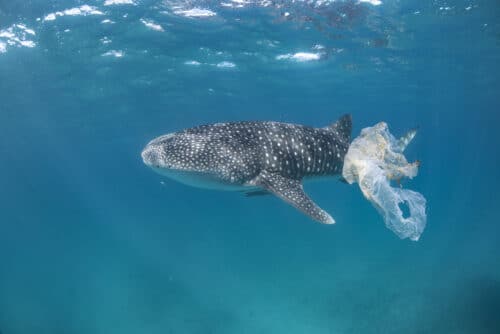Ocean and seas: what’s the difference?

Ocean and seas: what’s the difference?
Water covers about 71% of the planet’s surface, and oceans and seas hold roughly 97% of all Earth’s water.
Did you know that all ocean basins and seas are actually part of one huge body of water, connected throughout the world? This is called the Global Ocean and it is home to more than 230,000 marine creatures (and more to be discovered as most of it hasn’t even been explored yet!).
The fact that oceans are interconnected is also proven by thermohaline circulation (also known as the Global Ocean Conveyor or the Great Ocean Conveyor Belt), a phenomenon for which seawater circulates around all the Global Ocean, independent of man-made boundaries, and water at depth is replaced by water from the surface.
As we all know, however, human beings have divided this Global body of water in smaller parts, what we call seas and oceans, based on historical, geographical and cultural factors.
What’s the difference between ocean and seas?
Many people tend to use the terms sea and ocean interchangeably; from a geographical point of view, however, which is based on the study of the Earth’s surface, the two terms have distinct meanings.
Seas are generally smaller than the ocean, and are located at the point where the ocean meets land. Also, seas are often enclosed by land. Ocean, therefore, represents a much larger body of open water than a sea.
The full list of ocean basins and seas
Today, there are five recognized Ocean basins on our planet: the Pacific, Atlantic, Indian, Arctic and Southern Ocean basins.Let’s see their main characteristics.
-
Pacific Ocean basin
The Pacific Ocean basin is by far the largest and deepest ocean basin on the planet, occupying almost 30% of Earth’s surface. It stretches from the western coasts of North and South America to Oceania and eastern Asia, connecting to the Arctic and the Southern Ocean basin in the North and South respectively.
The name “Pacific” derives from Portuguese explorer Ferdinand Magellan who, during his journey to the Philippines, found it very peaceful.
The Pacific also contains the deepest spot on Earth: Challenger Deep in the Mariana Trench, east of the Philippines, at 11,034 m (36,201 ft).
-
Atlantic Ocean basin
The second-largest ocean basin is the Atlantic, which takes its name from Greek mythology: Atlas, a Titan God condemned to hold Earth on his shoulders for eternity.
This body of water has an elongated “S” shape, stretching between Africa and Europe, and the Americas, and connecting to the Arctic, and the Southern Ocean basin in the North and south.
In the West, the Atlantic goes all the way from North to South America. In the east, it connects to the Pacific Ocean basin at the tip of Africa, through the Southern Ocean basin. The 20° meridian divides the Atlantic from the Indian Ocean basin in the east.
Another man-made link between the Atlantic and the Pacific Ocean basins is the Panama Canal, created at the end of the 19th century thanks to extraordinary human labour.
-
Indian Ocean basin
The Indian Ocean basin comes after the Atlantic in terms of size. In the west, it reaches Africa and the Southern Ocean basin, and it stretches to the east until southern Asia and Australia. The 20° east meridian draws a line between the Indian and the Atlantic Ocean basin and the 147° east meridian creates the border with the Pacific.
The Indian Ocean basin takes up 70,560,000 sq km (27,240,000 sq mi) which is about 19.8% of all the water on Earth and its deepest recorded point is the Java Trench, south of Java, in the eastern part of the Indian Ocean basin; it is approximately 7,725 metres deep.
One interesting fact is that, at the bottom of the Indian Ocean basin lies the convergence of the African, Indian and Antarctic crustal plates.
-
Arctic Ocean basin
The Arctic Ocean basin is the smallest and coldest ocean basin in the world, it lies between Europe, Asia, and North America, mostly north of the Arctic Circle.The Arctic Ocean basin is 14,056,000 sq km (5,427,000 sq mi) in area, which makes it smaller than Russia.
In the past, this ocean basin was covered in ice all year round, but this is now drastically changing due to climate change and global warming. The melting ice sheets cause variations in salinity and subfreezing temperatures, affecting the balance of the whole planet.
-
Southern Ocean basin
The Southern Ocean basin covers approximately one-sixteenth of Earth’s ocean area, and it comes fourth in terms of dimensions. The Southern Ocean basin occupies 21,960,000 square km (8,479,000 square miles), and it holds 71,800,000 cubic km (17,226,000 cubic miles) of water.
The International Hydrographic Organization started to officially recognize this as an ocean basin only in 2000. This is due to the fact that it encircles Antarctica, following the 60th parallel South of the equator, and is made up by the portions of the Atlantic, Indian, and Pacific Oceans that surround the continent.
List of the world’s major seas
We all know the expression “seven seas”: its origin can be traced back to ancient times. This referred to different seas in different times of history. For example, Greek literature talks of the Aegean, Adriatic, Mediterranean, Black, Red, Caspian seas, and the Persian Gulf; in Mediaeval European literature, the phrase came to describe the North Sea, Baltic, Atlantic, Mediterranean, Black, Red, and Arabian seas.
Nowadays, we of course know that there are more than seven seas on our blue planet.
Let’s see a list of major seas of the world with a small description for each of them!
-
Philippine Sea – 5.695 million km2
-
Coral Sea- 4.791 million km2
-
American Mediterranean Sea – 4.200 million km2
-
Arabian Sea – 3.862 million km2
-
Sargasso Sea – 3.5 million km2
-
South China Sea – 3.5 million km2
-
Weddell Sea – 2.8 million km2
-
Caribbean Sea – 2.754 million km2
-
Mediterranean Sea – 2.510 million km2
-
Gulf of Guinea – 2.35 million km2
-
Tasman Sea – 2.3 million km2
-
Bay of Bengal – 2.172 million km2
-
Bering Sea – 2 million km2
-
Sea of Okhotsk – 1.583 million km2
-
Gulf of Mexico – 1.550 million km2
-
Gulf of Alaska – 1.533 million km2
-
Barents Sea – 1.4 million km2
-
Norwegian Sea – 1.383 million km2
-
East China Sea – 1.249 million km2
-
Hudson Bay – 1.23 million km2
-
Greenland Sea – 1.205 million km2
-
Somov Sea – 1.15 million km2
-
Mar de Grau – 1.14 million km2
-
Riiser-Larsen Sea – 1.138 million km2
-
Sea of Japan – 1.05 million km2
-
Argentine Sea – 1 million km2
-
East Siberian Sea – 987,000 km2
-
Lazarev Sea – 929,000 km2
-
Kara Sea – 926,000 km2
-
Scotia Sea – 900,000 km2
-
Labrador Sea – 841,000 km2
-
Andaman Sea – 797,700 km2
-
Laccadive Sea – 786,000 km2
-
Irminger Sea – 780,000 km2
-
Solomon Sea – 720,000 km2
-
Mozambique Channel – 700,000 km2
-
Cosmonauts Sea – 699,000 km2
-
Banda Sea – 695,000 km2
-
Baffin Bay – 689,000 km2
-
Laptev Sea – 662,000 km2
-
Arafura Sea – 650,000 km2
-
Ross Sea – 637,000 km2
-
Chukchi Sea – 620,000 km2
-
Timor Sea – 610,000 km2
-
North Sea – 575,000 km2
-
Bellingshausen Sea – 487,000 km2
-
Beaufort Sea – 476,000 km2
-
Red Sea – 438,000 km2
-
Black Sea – 436,000 km2
-
Gulf of Aden – 410,000 km2
-
Yellow Sea – 380,000 km2
-
Baltic Sea – 377,000 km2
-
Caspian Sea – 371,000 km2
-
Libyan Sea – 350,000 km2
-
Mawson Sea – 333,000 km2
-
Levantine Sea – 320,000 km2
-
Java Sea – 320,000 km2
-
Gulf of Thailand – 320,000 km2
-
Celtic Sea – 300,000 km2
-
Gulf of Carpentaria – 300,000 km2
-
Celebes Sea – 280,000 km2
-
Tyrrhenian Sea – 275,000 km2
-
Sulu Sea – 260,000 km2
-
Cooperation Sea – 258,000 km2
-
Persian Gulf – 251,000 km2
-
Flores Sea – 240,000 km2
-
Gulf of Saint Lawrence – 226,000 km2
-
Bay of Biscay – 223,000 km2
-
Aegean Sea – 214,000 km2
-
Gulf of Anadyr – 200,000 km2
-
Molucca Sea – 200,000 km2
-
Oman Sea – 181,000 km2
-
Ionian Sea – 169,000 km2
-
Gulf of California – 160,000 km2
-
Balearic Sea – 150,000 km2
-
Adriatic Sea – 138,000 km2
References
https://ontheworldmap.com/oceans-and-seas/
https://www.infoplease.com/world/geography/oceans-and-seas
https://www.nationalgeographic.org/encyclopedia/sea/
https://oceanservice.noaa.gov/facts/oceanorsea
https://www.geographyrealm.com/what-is-the-difference-between-a-sea-and-an-ocean/



